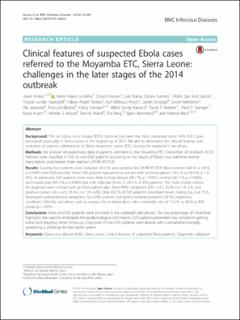| dc.contributor.author | Arranz, Javier | |
| dc.contributor.author | Lundeby, Karen Marie | |
| dc.contributor.author | Hassan, Shoaib | |
| dc.contributor.author | Fuentes, Luis Matías Zabala | |
| dc.contributor.author | Garcés, Pedro San José | |
| dc.contributor.author | Haaskjold, Yngvar Lunde | |
| dc.contributor.author | Bolkan, Håkon Angell | |
| dc.contributor.author | Krogh, Kurt | |
| dc.contributor.author | Jongopi, James | |
| dc.contributor.author | Mellesmo, Sindre | |
| dc.contributor.author | Jøsendal, Ola | |
| dc.contributor.author | Øpstad, Åsmund | |
| dc.contributor.author | Svensen, Erling | |
| dc.contributor.author | Kamara, Alfred Sandy | |
| dc.contributor.author | Roberts, David P. | |
| dc.contributor.author | Stamper, Paul D. | |
| dc.contributor.author | Austin, Paula | |
| dc.contributor.author | Moosa, Alfredo J. | |
| dc.contributor.author | Marke, Dennis | |
| dc.contributor.author | Berg, Åse | |
| dc.contributor.author | Blomberg, Bjørn | |
| dc.contributor.author | Riera, Melcior | |
| dc.date.accessioned | 2021-08-09T12:05:14Z | |
| dc.date.available | 2021-08-09T12:05:14Z | |
| dc.date.created | 2016-07-18T10:53:14Z | |
| dc.date.issued | 2016 | |
| dc.identifier.issn | 1471-2334 | |
| dc.identifier.uri | https://hdl.handle.net/11250/2767027 | |
| dc.description.abstract | Background
The last ebola virus disease (EVD) outbreak has been the most important since 1976. EVD cases decreased drastically in Sierra Leone at the beginning of 2015. We aim to determine the clinical findings and evolution of patients admitted to an Ebola treatment center (ETC) during the epidemic’s late phase.
Methods
We analyze retrospectively data of patients admitted to the Moyamba ETC (December 2014-March 2015). Patients were classified in EVD or non-EVD patients according to the results of Ebola virus real-time reverse transcription polymerase chain reaction (ZAIRE-RT-PCR).
Results
Seventy-five patients were included, 41.3 % were positive for ZAIRE-RT-PCR. More women (68 % vs 28 %, p = 0.001) were EVD-positive. More EVD patients had previous contact with an Ebola patient (74.2 % vs 36.3 %, p < 0.001). At admission, EVD patients were more likely to have fatigue (96.7 %, p < 0.001), diarrhea (67.7 %, p = 0.002), and muscle pain (61.3 %, p = 0.009); but only objective fevers in 35.5 % of EVD patients. The most reliable criteria for diagnosis were: contact with an Ebola patient plus three WHO symptoms (LR + =3.7, 95 % CI = 1.9–7.3), and positive contact (LR + =2.3, 95 % CI = 1.15–4.20). Only 45.2 % of EVD patients developed fevers during stay, but 75 % developed gastrointestinal symptoms. Non-EVD patients had gastrointestinal problems (33 %), respiratory conditions (26.6 %), and others such as malaria, HIV or tuberculosis with a mortality rate of 11.4 %. vs 58 % in EVD group (p < 0.001).
Conclusions
More non-EVD patients were admitted in the outbreak’s late phases. The low percentage of initial fever highlights the need to emphasize the epidemiological information. EVD patients presented new symptoms getting worse and requiring closer follow-up. Diagnoses of non-EVD patients were diverse with a remarkable mortality, presenting a challenge for the health system. | en_US |
| dc.language.iso | eng | en_US |
| dc.publisher | BMC | en_US |
| dc.rights | Navngivelse 4.0 Internasjonal | * |
| dc.rights.uri | http://creativecommons.org/licenses/by/4.0/deed.no | * |
| dc.title | Clinical features of suspected Ebola cases referred to the Moyamba ETC, Sierra Leone: Challenges in the later stages of the 2014 outbreak | en_US |
| dc.type | Journal article | en_US |
| dc.type | Peer reviewed | en_US |
| dc.description.version | publishedVersion | en_US |
| dc.rights.holder | Copyright 2016 The Authors | en_US |
| dc.source.articlenumber | 308 | en_US |
| cristin.ispublished | true | |
| cristin.fulltext | original | |
| cristin.qualitycode | 1 | |
| dc.identifier.doi | 10.1186/s12879-016-1609-9 | |
| dc.identifier.cristin | 1368373 | |
| dc.source.journal | BMC Infectious Diseases | en_US |
| dc.identifier.citation | BMC Infectious Diseases. 2016, 16, 308 | en_US |
| dc.source.volume | 16 | en_US |

